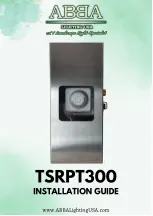
IM-T-296C Jul. 2021
DTPA-A-5K Wire-type Displacement Transducer
INSTRUCTION MANUAL
Thank you for purchasing this KYOWA product. Before using it, read this
instruction manual carefully. Also, keep the manual within easy reach so that
you can refer to it whenever necessary.
Specifications and dimensions described in this manual could be changed
without notice. Please visit our website for the latest version.
1. Calling the operator’s attention
The following cautionary symbols and headlines are used to invite the
operator's attention. Be sure to observe the accompanying precautions in
order to safeguard the operator and preserve the performance of the
instrument.
Warning
Improper handling may cause serious injury to the
operator.
Caution
Cautions are given to invite the operator’s attention,
in order to avoid instrument failure or mal-function.
2. Important notice
Unless specified, strain-gage transducers must not be used under hydrogen
environment.
3. Safety precautions
Warning
The DTPA-A has the mechanism that winds the wire automatically.
As you release the wire, the DTPA-A winds the wire furiously and
damages your body. Do not release the wire you are holding.
4. Handling precautions
Caution
Do not release the wire you are holding. Also, do not apply sudden
shocks to the wire. Or, the product may be damaged.
Do not disassemble the displacement transducer.
Do not use the transducer where it may be exposed to water or much
dust.
Do not use the transducer in vibrations.
Make sure that the bending radius of cable is longer than 6 times of a
diameter of the cable.
5. Installation
5.1
Mount the DTPA-A onto the steady points (vertical or horizontal) by using
the hexagon socket head bolts (M4, L6 or more).
* Customers are required to purchase the hexagon socket head bolts.
5.2
The ZERO balance is -1.5 to -1.2 mV/V.
5.3
Make sure the rubber stopper is securely positioned in the guide. With
holding the rubber stopper with one hand, pull out the wire. If you release
the wire, the DTPA-A slowly winds the wire.
5.4
With the wire pulled out 5 to 20 mm, lock the swivel.
5.5
Remove the rubber stopper from the guide. Open the slit of the rubber
stopper and remove it from the wire.
6. Connection
6.1
Connect the transducer to a strain amplifier.
6.2
When using a strain amplifier other than KYOWA, wiring to the connector
plug should be made as illustrated.
6.3
It is required to heat-run for 5 to 10 minutes before starting the
measurement.
7. Conversion
7.1
Use the calibration constant described on the Test Data Sheet to convert
a measured value into a displacement value.
7.2
When a strain amplifier is in use, output reads in ×10
-6
equivalent strain.
Find a displacement value corresponding to ×10
-6
strain. Then, obtain a
displacement value through multiplication using the following equation.
Displacement (mm)
=
Strain amplifier’s output (×10
-6
strain)
x Calibration constant (mm
/
1×10
-6
strain)
7.3
When using an amplifier of other type or a recorder, first find the exact
bridge exciting voltage applied. Second, find the displacement value that
corresponds to 1(μV) output voltage against 1(V) bridge excitation
voltage. Then, obtain the displacement value through multiplication using
the following equation.
Displacement (mm) =
Bridge output voltage (μV)
×Calibration constant (mm
/
1μV/V)
Bridge excitation voltage (V)
8. Maintenance and inspection
8.1
Avoid water, oil and dust on the displacement transducer.
8.2
Recommend calibrate the product once a year or so. (Contact your
KYOWA representative.)
8.3
If an abnormal initial value or reading appears, measure input resistance,
output resistance as well as insulation resistance (which should be
100M or more) between the main body and red to green.
If abnormal resistance is found, the cause may be failure of the sensing
element. In this case, contact your KYOWA representative for necessary
inspection.
Caution
To measure insulation resistance, apply a voltage lower than 50V to the
insulation resistance tester.






















